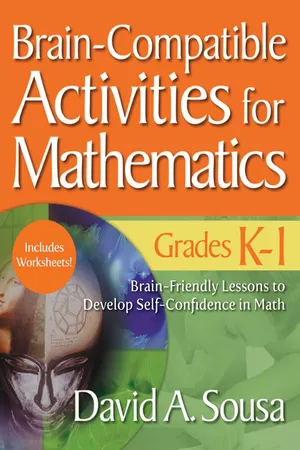![]()
1
Whole Numbers
Seeing Dots
How Many?
Number Path
Counting Sets
More or Less
Who’s First?
Number Slap
A Ten Count!
Number Jingle!
SEEING DOTS
Objective
Students will use mental imagery to tell how many dots are on a card.
Anticipatory Set
Show students a photo of one object. Hold it up for 3 seconds, and then place it facedown so students cannot see it. Ask students to name what they saw. Discuss how we can look at something quickly and identify it.
Purpose
Tell students they are going to practice identifying how many dots are on a card. Explain that they should try to find the card as quickly as they can.
Input
Before the activity, make a class set of the Dot Cards reproducibles. Cut out each set of cards, and paperclip each set together. Show one card from a set to students, and ask them to say how many dots are on the card. Repeat with other cards from the set. It is important that you only briefly show each card so students do not rely on counting to identify the number of dots. Hold up each card for about 3 seconds.
Subitizing is best practiced with dot card patterns, rather than with manipulatives, to enhance imagery and eliminate counting by ones.
Modeling
Tell students you arc going to give them a set of dot cards. Explain that you will call out a number, and they will quickly find the card that has that number of dots. Model laying out the dot cards faceup. Then say “four,” and pick up the dot card with four dots. Hold the card in the air and show students. Say, “I did not count the dots on each card. I quickly glanced at all the cards and picked up the one that had four dots.”
Checking for Understanding
Be sure that students understand that they are trying to identify and pick up the correct card as fast as they can.
Guided Practice
Distribute the sets of dot cards. Start out by giving students dot cards 1 through 6. Have students lay their cards faceup. Call out a number between 1 and 6, and ask students to show you that card. Quickly scan the room to see which students are choosing the correct card. Repeat the steps until most students are correctly identifying the cards. Then have students place those cards aside, give them dot cards 7 through 12, and repeat the activity. As students become more proficient, randomly choose any set of six dot cards.
Closure
Tell students to think about what they learned today. Ask them if they had to count the number of dots on each card each time they looked for the matching card or if they just looked at the cards. Invite students to write or dictate one important thing they learned in their math journals.
Independent Practice
Have students place a set of dot cards facedown on their desks. Have them flip over a card and say how many dots are on the card. Have them continue until they have practiced each card a few times.
Dot Cards
Dot Cards
HOW MANY?
Objective
Students will count objects using one-to-one correspondence.
Anticipatory Set
Ask one student who is wearing a shirt with buttons to stand up. Point out the buttons and ask aloud, “I wonder how many buttons are on this shirt.” Explain that one way to find out is to count the buttons. Point to each button as you count it aloud.
Purpose
Tell students that they will count objects to find out how many there are.
Input
Remind students that when we count objects, we count each object only one time.
Modeling
Use two-sided color chips, or glue two different-colored sheets of construction paper back-to-back, and then cut the paper into small squares. Lay five chips in a row on a table. Have the same color of each chip facing up. Then flip over each chip as you count aloud. Ask students, “How many chips are there? I counted five chips.”
Checking for Understanding
Make sure that students understand that the last number counted represents the amount. Flip over three cards. Ask students to point to the square that identifies the quantity.
Guided Practice
Give each student a set of 10 chips. Ask students to place their chips in a row with the same color showing on each chip. Tell students to count the chips. Tell them to turn over each chip as they count it. When they get to the fourth chip say, “Stop.” Then ask students, “How many chips did you count?” Repeat the process, stopping at different amounts. Then have students pick up a handful of the chips and count the chips in their hands. Ask them to put their hands behind their backs and ask, “How many chips did you count?”
Using chips with different-colored sides can enhance students’ understanding of the cardinal principle.
Closure
Tell students to follow the directions you give them. Say, “Clap five times.” Have students clap and count to five. Repeat with other directions such as, Stomp your feet four times, Jump up and down six times, and Touch your toes three times. Then ask students to draw a small set of objects in their math journals and count the number of objects. Have them write and complete the sentence frame, “I counted [number of items] [name of item].”
Independent Practice
Give each student a copy of the Counting Objects reproducible to complete individually. Tell students that they will count the number of objects in each set and then write the number. The objects being counted are of various sizes and in various configurations to represent the concept that number words describe how many objects and not their arrangement or size.
Counting Objects
Directions: Write how many objects are in each set.
NUMBER PATH
Objectives
Students will practice counting forw...




